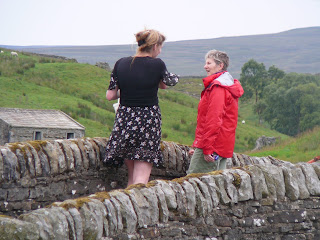Our final two days of walking were unusual in that we started downhill for a change. Yesterday it was Red House Farm down to Beggar's Bridge and today it was Intake Farm down to Littlebeck. From there we had a gradual ascent through the woods of oak and beech and alder past Falling Foss, a 20m waterfall, and the hollowed out stone of The Hermitage where the acoustics were so wonderful we sang "Hey Rain" and a few French songs to celebrate 14th July.
Once we got up onto open moors again we could see the North Sea, suddenly very close, and it seemed like an easy stroll to High Hawsker for lunch. However the Graystone Hills are not well signposted and we strayed briefly onto another path. For the first time on the entire walk I felt the need to check our location on the GPS on the iPad. We discovered we were only about 10 metres from the right path and were soon back on track.
Prior to that our trek across the moor had been interrupted by an encounter with an adder basking on the path. It slid lazily and innocently away and did not seem at all perturbed by our presence. However the Welsh doctor we met at Intake Farm assured us that a couple of people die every year from adder bites so we treated it with due respect.
After lunch at High Hawsker we walked on until we rejoined the Cleveland Way along the North Sea coast. We were not quite at our destination ... but we had walked coast to coast! The last few kilometres were an easy stroll along the cliffs which we did not want to rush. After 300 km we did not want this to end and would readily have walked on and on if the North Sea were not in the way. The sun had come out and would accompany us all the way home.
Reaching the North Sea coast
Our first glimpse of Robin Hoods Bay came with less than a kilometre to go. Robin Hoods Bay, a charming old fishing village with its labyrinthine streets and alleyways. One day soon, maybe a 100 years from now, the North Sea will claim it, just as it has swallowed so much of the east coast in recent centuries. Or perhaps the concrete sea wall will extend its life for a few hundred years more. Let's hope so.
We trundled into town with both joy and sadness. We met Tony and Angela from Wales, already aboard the 4pm Packhorse bus about to go back to Kirkby Stephen. They bolted from the bus to congratulate us. There was a private feeling of camaraderie that was out of reach of the day trippers and holiday makers around us.
Further down the road we met Ian and Rosalie from Lincolnshire as they made their way back up the hill. Again there was a genuine warmth that came from sharing the coast to coast experience.
At last we reached the end of the road and there it was, after nearly half a million steps. The North Sea at high tide, waves breaking a yard or two in front of us. The Bay Hotel was to our left, bathed in sunlight with a dozen or more weary walkers quietly celebrating their personal achievements.
We took off our boots and dipped our toes in, much as we had at St Bees, which now seemed such a long, long time ago. We found our pebbles from the St Bees beach and hoicked them into the North Sea. Maybe all these pebbles (some 12,000 a year) will help keep the east coast above water?
Then it was into the Bay Hotel to sign the register and call for a celebratory drink.
We walked back up the hill to our B&B before coming back for a meal. We clung to the moment not wanting it to end, knowing that tomorrow we would be heading in different directions ... and in motorised vehicles at that.
Every review of famous walks we have read puts the Milford Track as #1 but we can honestly say (having walked Milford in fantastic weather last year) that this was every bit as good, if not better.
Credits:
- Heather, David and Nick - thanks for sharing the adventures with us
- Coast to Coast Packhorse - faultless, friendly service
- Our B&Bs, farmhouses and hotels - almost without exception they offered excellent accommodation, friendly service, affordable meals and satisfying drinks
- Those responsible for the three National Parks (lakes, dales, moors) and maintaining the quality of the Coast to Coast track and signposts
- Alfred Wainwright - what a great idea!
- The Met Office for giving us such great weather (even when you didn't predict it!)
- Our fellow coast to coast walkers, some of whom we never got to know on a names basis but they were nearly all cheerful, helpful and positive
- Our blog readers - thank you for your messages of support - they really helped!





















































